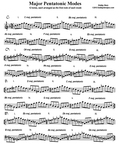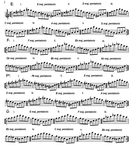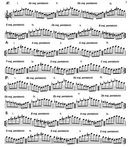
Pentatonic Scales (defined as any scale containing 5 notes) are evident, even prominent, in many styles of music from all over the world. The pentatonic scale is probably as old as music itself.
The Major Pentatonic Scale is derived from the Major Scale by omitting the 4th & 7th degrees. As there are 12 Major keys, there are also 12 distinct Major Pentatonics.
If, however, we choose, to begin each mode on the same note, we then generate five individual pentatonic scales, each from a different key.
For example (click on graphic above), the note C would be the:
first tone of the "i mode" of C maj. pentatonic (C-D-E-G-A)
first tone of the "ii mode" of Bb maj. pentatonic (C-D-F-G-Bb)
first tone of the "iii mode" of Ab maj. pentatonic (C-Eb-F-Ab-Bb)
first tone of the "iv mode" of F maj. pentatonic (C-D-F-G-A)
first tone of the "v mode" of Eb maj. pentatonic (C-Eb-F-G-Bb)
In other words, there are 5 pentatonic choices for each of the 12 chromatic scale tones, giving us 60 pentatonic modes overall.
This is a great exercise for gaining facility with pentatonics and for being able to play up to five pentatonics off of any given note, ascending or descending.
This scheme can be used for any five note scale. It gets really interesting when used with pentatonics derived from melodic & harmonic minor as well as diminished scales, for example.
So check it out. At first practice slow, but with a flow. Change the range, if you need to. Strive to memorize.
Enjoy!
B.Stern



 RSS Feed
RSS Feed








